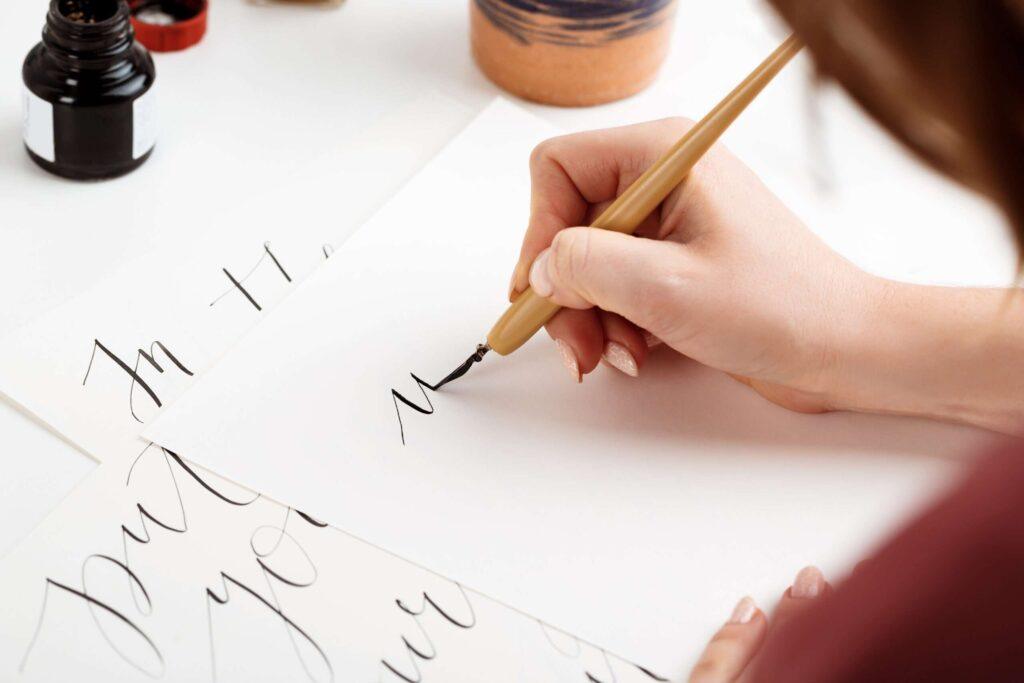In today’s world, where technology plays such an important role in our daily lives, we often forget about the ancient art of calligraphy. However, it is worth considering why it is important to introduce children to the world of beauty and precision of calligraphy, especially in the era of tablets, smartphones, and computers.
Calligraphy – what is it?
Calligraphy is the art of beautiful writing, which has a long and fascinating history. In fact, calligraphy is much more than just a way to create beautiful letters. It is also a form of self-expression, meditation, and creativity. Through calligraphy, we can connect with tradition, draw inspiration from the past, and at the same time develop artistic skills.
In practice, calligraphy involves precise and aesthetic writing of letters. Various writing styles are used, such as italic, Gothic, Arabic, or Chinese calligraphy. Each style has its characteristic features that give the written content a unique appearance.
How to start your adventure with calligraphy?
Choose the right tools. The first of these is a nib or calligraphy pen, which allows for creating lines of varying thickness. Next, we need ink or calligraphy paint to give our writing an intense color. Additionally, good quality paper and a ruler and square are also important to help us maintain even spacing between letters.
Once we have the right tools, we can start practicing. Calligraphy requires patience and regular training. Initially, we can focus on learning the basic letters and connecting them into words. Gradually, we can experiment with different styles and create our own projects, such as invitations, holiday cards, or posters.
-
Learning the basic letters. Before you move on to more advanced styles, it is worth learning the basic letters. Choose one writing style, such as simple italic, and focus on mastering the basic shapes of the letters. Practice the movements of the pen, maintaining a steady pressure and even proportions of the letters.
- Focus on technique. Calligraphy requires precision and control. Remember to maintain an even pressure of the pen on the paper. Try to keep a consistent line thickness and control the fluidity of your movements. Practice your technique regularly, and over time you will notice greater progress.
- Explore different styles. Once you have mastered the basics, you can start experimenting with different calligraphy styles. Try Gothic, Arabic, or perhaps Chinese calligraphy. Each style has its unique features and beauty. Don’t be afraid to experiment and create your own compositions.
- Maintain regular practice. As in every field, regular practice is key. Take time for daily calligraphy exercises. Even a few minutes a day can yield significant results. Try to be patient and don’t get discouraged during tougher moments. Every progress is valuable.
-
Get inspired by the masters. Don’t forget to explore and draw inspiration from the works of calligraphy masters. Browse books, study the works of artists, and look for patterns that fascinate you. Use the Internet, where you will find many tutorials and guides.
Why is it worth getting interested in calligraphy?
First of all, calligraphy develops children’s manual skills. Writing beautiful letters requires precision and hand control. Children learn the correct hand positioning, how to control pressure, and fluidity of movement. These skills are not only useful when writing but also positively impact a child’s motor development. This focus on details and control over movement are skills that are essential in many other areas of life. Examples include art, surgery, or even computer programming, where precision and control over movement are crucial.
Secondly, calligraphy teaches children patience. In an age of instant access to information and a fast-paced life, patience has become an increasingly rare trait. Calligraphy requires focus, slowness, and accuracy. A child must dedicate time and attention to create beautiful letters. It is an excellent way to develop concentration and perseverance skills.
Thirdly, calligraphy conveys aesthetics and respect for beauty. In a digital world where most texts are typed on a keyboard, it is worth paying attention to the aesthetics and elegance of traditional writing. Beautiful letters have their charm and affect our senses. Calligraphy teaches children that the way they write matters. Learning calligraphy can spark their interest in art, design, and aesthetics.
Calligraphy helps in developing creativity. Writing beautiful letters requires imagination and the ability to compose harmonious shapes. Children who learn calligraphy learn to see writing as an artistic form. They can experiment with different styles, decorations, and embellishments, which enhances their creativity and aesthetic sense.
The ability to write beautifully translates into concise and readable communication. Legible writing is important in school, when taking notes, and also in professional life. Nowadays, most communication occurs electronically, but that doesn’t mean it’s not worth knowing how to write legibly by hand. Some situations still require traditional writing, such as filling out forms or signing documents.
Calligraphy gives us the opportunity to break away from our daily routine and discover our creativity. It can also be an excellent form of relaxation and meditation, where we can focus solely on the movements of the pen and the shapes of the letters.
In today’s fast-paced world, calligraphy can be our oasis of calm and an escape from technological chaos. Through calligraphy, we can also explore different cultures that convey their beauty and wisdom to us.
Finally, calligraphy is universal and timeless. Although technology continues to evolve, the beauty and value of handwriting remain unchanged. The skill of beautiful calligraphy will be useful throughout life – both in school and in adulthood. Whether it’s writing letters, creating invitations, or decorating notes, calligraphy provides an opportunity to express oneself in a unique way.
Therefore, it is worth ensuring that calligraphy does not disappear from our children’s lives. We can start with simple exercises in writing letters and developing fine motor skills. We can also encourage children to write beautiful notes or cards instead of sending regular text messages. There are many courses, books, and educational materials that can help us teach calligraphy.
Have fun, be patient, and experiment. Let your beautiful letters inspire and enchant others!


